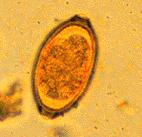Difference between revisions of "Capillaria"
| Line 48: | Line 48: | ||
==References== | ==References== | ||
| + | {{Learning | ||
| + | |flashcards = [[Avian Medicine Q&A 09]] | ||
| + | }} | ||
| + | |||
Trees, A. (1987) '''Parasitic conditions in poultry 2: Helminths and arthropods''' ''In Practice''; 9:157-161 | Trees, A. (1987) '''Parasitic conditions in poultry 2: Helminths and arthropods''' ''In Practice''; 9:157-161 | ||
Revision as of 14:37, 1 August 2011
| Capillaria spp. | |
|---|---|
| Kingdom | Animalia |
| Phylum | Nematoda |
| Class | Adenophorea |
| Sub-class | Enoplia |
| Order | Trichurida |
| Super-family | Trichuroidea |
| Family | Trichinellidae |
| Genus | Capillaria |
| Species | Many |
Overview
Capillaria spp. are similar to other members of the Trichuroidea superfamily such as Trichuris but with slight differences in morphology of the anterior and posterior ends. Although they are found in domestic mammals and some reptiles these species are of greatest importance in birds. The predilection sites vary between species and are not restricted to the gastrointestinal system. Important species include; C. annulata, C. anatis and C. contorta.
Identification
Capillaria are extremely thin, filamentous worms measuring 15-25mm long (males) and 35-80mm long (females). Males have a single spicule and many have a primitive bursa like structure. The eggs have bipolar plugs and thick shells, the size can vary between species.
Important Species
C. annulata
This species affects many species of wild birds as well as domesticated poultry and ducks. The earthworm is the intermediate host for this species, making it difficult to control. Young birds are more susceptible to the disease. Immune adults may be carriers. The predeliction site for this worm is the oesophagus of the bird where it will bury the anterior end into the mucosa causing inflammation. High levels can result in marked thickening of the oesophageal wall and can be fatal. The presence of these worms in low numbers may be a cause of ill thrift in production birds, though in high number emaciation can be seen.
C. contorta
Also known as: Eucoleus contorta
As with C. annulata this species is found in the oesophagus and crop of domestic poultry and many wild birds. Both the adults and the eggs of this species are smaller in size but the general morphology remains the same. The earthworm is normally the intermediate host but it is possible for this species to have a direct life cycle with the L1 embryonated egg as the infective stage. Clinical signs are rare with low levels of infection though they can be associated with a loss in productivity, high parasite burdens will result in emaciation and anaemia and can be fatal. The primary epidemiological concern with this parasite is its ability to have a direct life cycle and so birds kept indoors and away from the intermediate host may still become infected.
C. aerophila
Capillaria aerophila is associated with respiratory disease of cats and dogs. The worm can be found in the nasal passages, sinuses, trachea and bronchi. The presence of the worms causes a mild catarrhal inflammation and can cause coughing in dogs but not in all cases. In heavy infestation may cause obstruction of the lumen of airways and may develop into secondary bronchopneumonia
Clinical Signs
Young birds exhibit the most serious clinical signs, including: weight loss, diarrhoea, regurgitation, anaemia and oral necrotic plaques.
Diagnosis
Faecal flotation can be carried out to identify the typical barrel-shaped eggs.
However, eggs laid within the gastrointestinal epithelium are only released into the lumen of the digestive tract when the epithelium sloughs. Therefore, severe clinical signs may be associated with negative or low faecal egg counts. Therefore diagnosis is usually made on necropsy examination of the oesophagus and intestines. The worms are small and must be looked for carefully in mucosal washings under a dissecting microscope.
Treatment
Treatment can be challenging as Capillaria species often demonstrate multiple drug resistance. Fenbendazole, mebendazole and ivermectin have been used and efficacy of therapy should be checked through repeat faecal flotation tests.
References
| Capillaria Learning Resources | |
|---|---|
 Test your knowledge using flashcard type questions |
Avian Medicine Q&A 09 |
Trees, A. (1987) Parasitic conditions in poultry 2: Helminths and arthropods In Practice; 9:157-161
Lloyd, C. (2003) Avian Practice: Control of nematode infections in captive birds In Practice; 25:198-206
Saif, Y. (2003) Diseases of Poultry Wiley-Blackwell
Literature Search
Use these links to find recent scientific publications via CAB Abstracts (log in required unless accessing from a subscribing organisation).
Capillaria publications since 2000
| This article has been peer reviewed but is awaiting expert review. If you would like to help with this, please see more information about expert reviewing. |

